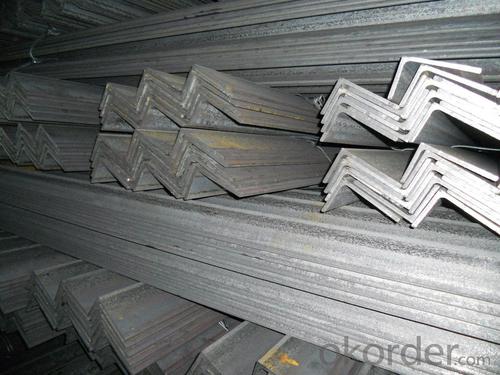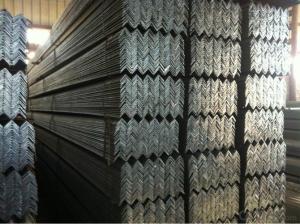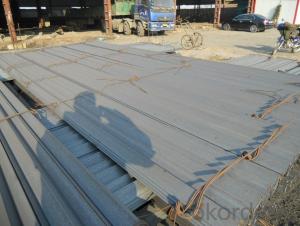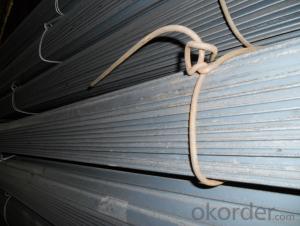Carbon Steel Unequal Angle with High Quality
- Loading Port:
- China Main Port
- Payment Terms:
- TT or LC
- Min Order Qty:
- 100 m.t.
- Supply Capability:
- 10000 m.t./month
OKorder Service Pledge
OKorder Financial Service
You Might Also Like
Product Description:
OKorder is offering Carbon Steel Unequal Angle with High Quality at great prices with worldwide shipping. Our supplier is a world-class manufacturer of steel, with our products utilized the world over. OKorder annually supplies products to African, South American and Asian markets. We provide quotations within 24 hours of receiving an inquiry and guarantee competitive prices.
Product Applications:
Carbon Steel Unequal Angle with High Quality are ideal for structural applications and are widely used in a variety of architectural and engineering structures, such as beams, bridges, ship; transmission tower, reaction tower; lifting transportation machinery; industrial furnace; container frame, warehouse goods shelves, etc
Product Advantages:
OKorder's Carbon Steel Unequal Angle with High Quality are durable, strong, and wide variety of sizes.
Main Product Features:
· Premium quality
· Prompt delivery & seaworthy packing (30 days after receiving deposit)
· Can be recycled and reused
· Mill test certification
· Professional Service
· Competitive pricing
Product Specifications:
Manufacture: Hot rolled
Grade: Q195 – 235
Certificates: ISO, SGS, BV, CIQ
Length: 6m-12m, as per customer request
Packaging: Export packing, nude packing, bundled
| UNEQUAL ANGLE STEEL | |||||
| size(mm) | a(mm) | a1(mm) | thickness(mm) | kg/m | length(m) |
| 75*50*5 | 75 | 50 | 5 | 4.808 | 6m,9m,12m |
| 75*50*6 | 75 | 50 | 6 | 5.699 | 6m,9m,12m |
| 75*50*8 | 75 | 50 | 8 | 7.431 | 6m,9m,12m |
| 100*75*7 | 100 | 75 | 7 | 9.34 | 6m,9m,12m |
| 100*75*8 | 100 | 75 | 8 | 10.6 | 6m,9m,12m |
| 100*75*9 | 100 | 75 | 9 | 11.8 | 6m,9m,12m |
| 100*75*10 | 100 | 75 | 10 | 13 | 6m,9m,12m |
| 100*75*12 | 100 | 75 | 12 | 15.4 | 6m,9m,12m |
| 125*75*7 | 125 | 75 | 7 | 10.7 | 6m,9m,12m |
| 125*75*8 | 125 | 75 | 8 | 12.2 | 6m,9m,12m |
| 125*75*9 | 125 | 75 | 9 | 13.6 | 6m,9m,12m |
| 125*75*10 | 125 | 75 | 10 | 15 | 6m,9m,12m |
| 125*75*12 | 125 | 75 | 12 | 17.8 | 6m,9m,12m |
| 150*90*8 | 150 | 90 | 8 | 14.7 | 6m,9m,12m |
| 150*90*9 | 150 | 90 | 9 | 16.4 | 6m,9m,12m |
| 150*90*10 | 150 | 90 | 10 | 18.2 | 6m,9m,12m |
| 150*90*12 | 150 | 90 | 12 | 21.6 | 6m,9m,12m |
| 200*100*10 | 200 | 100 | 10 | 23 | 6m,9m,12m |
| 200*100*12 | 200 | 100 | 12 | 27.62 | 6m,9m,12m |
| 200*100*15 | 200 | 100 | 15 | 34.04 | 6m,9m,12m |
FAQ:
Q1: what is the difference between actual weight and theoretical weight?
A1: All the section steel has two weights: actual weight and theoretical weight. Actual weight is the weighing out when the product delivered from the mill. Theoretical weight is calculated by pieces. The invoice can be based on each of them as your request.
Q2: How do we guarantee the quality of our products?
A2: We have established an advanced quality management system which conducts strict quality tests at every step, from raw materials to the final product. At the same time, we provide extensive follow-up service assurances as required.
Q3: How soon can we receive the product after purchase?
A3: Within three days of placing an order, we will arrange production. The normal sizes with the normal grade can be produced within one month. The specific shipping date is dependent upon international and government factors, the delivery to international main port about 45-60days.
Images:
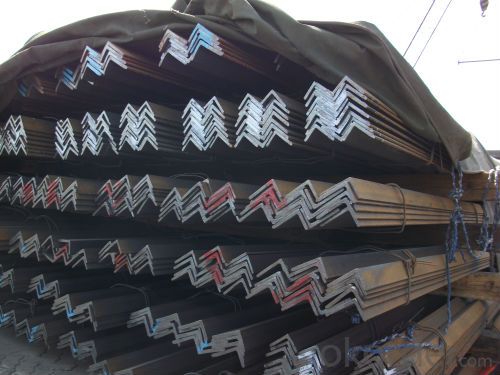
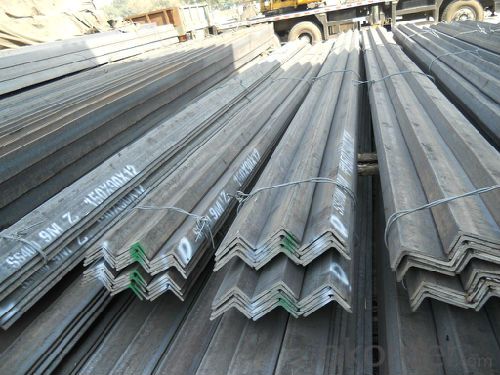
- Q: What is the maximum load capacity of a steel angle?
- The maximum load capacity of a steel angle depends on various factors such as the dimensions, thickness, and quality of the steel angle. It is essential to consult engineering specifications or contact a structural engineer to determine the specific maximum load capacity for a particular steel angle.
- Q: Can steel angles be used for architectural detailing?
- Indeed, architectural detailing can make use of steel angles. These versatile structural elements find application in diverse architectural scenarios. They serve to provide stability and support to structures, fulfilling framing, bracing, and reinforcing purposes. Examples of steel angle implementation can be observed in architectural features like window frames, door frames, staircases, and handrails, among others. Their inherent strength and durability render them fitting for both interior and exterior architectural designs. Furthermore, steel angles can be effortlessly tailored and manufactured to meet precise design specifications, empowering architects to conceive distinctive and visually appealing architectural details.
- Q: Can steel angles be used for manufacturing playground equipment?
- Yes, steel angles can be used for manufacturing playground equipment. Steel angles provide strength and stability, making them suitable for constructing various playground structures such as slides, swings, and climbing frames.
- Q: What are the different methods of connecting steel angles?
- Different methods can be used to connect steel angles, depending on the application and desired strength and durability. Welding is a widely used technique that involves melting the metals at the joint and allowing them to cool and solidify, creating a strong and permanent bond. Various welding techniques, such as arc welding, MIG welding, or TIG welding, can be employed to achieve a high level of strength and rigidity in the connection. Bolting is another common method that involves using bolts, nuts, and washers to secure the angles together. This method allows for easy disassembly and reassembly if necessary, and the level of tightness and strength in the connection can be adjusted by tightening the bolts. However, bolting may not provide the same level of strength as welding in certain applications. Mechanical connectors offer an alternative to welding and bolting. These pre-engineered devices, such as plates, brackets, or clips, are specifically designed for connecting steel members. They can be fastened to the angles using bolts or screws, providing ease of installation, flexibility, and the ability to accommodate movement and adjustments. Adhesive bonding is another method that involves using industrial-grade adhesives to join steel angles. This technique can provide a strong and durable connection, especially when combined with mechanical fasteners. Adhesive bonding is often used in situations where welding or bolting may not be suitable or practical. When selecting the appropriate method of connecting steel angles, it is important to consider factors such as load-bearing capacity, environmental conditions, and aesthetic requirements. Consulting with a structural engineer or a professional experienced in steel fabrication can help determine the most suitable connection method for a specific project.
- Q: Can steel angles be used in seismic or high-wind areas?
- Yes, steel angles can be used in seismic or high-wind areas. Steel angles are commonly used in construction for their strength and durability. They provide structural support and can withstand seismic forces and high winds when properly designed and installed. The use of steel angles in these areas is often subject to specific building codes and regulations, which ensure that the structures are capable of withstanding the forces generated by earthquakes or strong winds. Engineering analysis and design considerations must be taken into account to ensure the appropriate size, configuration, and connection details of the steel angles in order to meet the required safety standards.
- Q: What is the maximum length for a steel angle?
- The maximum length for a steel angle can vary depending on the specific type and size of the angle, as well as the manufacturing capabilities of the steel supplier. Generally, steel angles are available in standard lengths ranging from 20 feet to 40 feet. However, longer lengths may be possible through custom orders or special production processes. It is recommended to consult with a steel supplier or manufacturer to determine the maximum length that is readily available or can be obtained for a specific type of steel angle.
- Q: Can steel angles be used in high-temperature applications?
- Yes, steel angles can be used in high-temperature applications. Steel is a strong and versatile material that maintains its structural integrity even at high temperatures. However, it is important to consider the specific grade and alloy of steel being used, as some may have limitations on their maximum operating temperature. Additionally, factors such as the duration of exposure to high temperatures and the presence of other corrosive elements should be considered when determining the suitability of steel angles for a particular high-temperature application.
- Q: What are steel angles used for?
- Steel angles are commonly used in construction and manufacturing industries for a variety of purposes. One of the main uses of steel angles is in structural applications. They are often used as supports, braces, and reinforcements in buildings, bridges, and other infrastructure projects. The L-shape of the angle provides added strength and stability, making it an ideal choice for constructing load-bearing structures. Steel angles are also used in the manufacturing industry for fabricating various products. They can be welded, drilled, and cut to create custom shapes and structures. They are commonly used as frames, brackets, and supports for machinery, equipment, and vehicles. Additionally, steel angles are used in the fabrication of furniture, shelves, racks, and other storage solutions. Their sturdy construction makes them suitable for supporting heavy loads, making them ideal for applications in warehouses, garages, and factories. In summary, steel angles are versatile and widely used in construction and manufacturing industries for their strength, stability, and adaptability. From supporting structures to fabricating products, they play a crucial role in various applications.
- Q: Can steel angles be used for window frames?
- Yes, steel angles can be used for window frames. Steel angles provide stability, strength, and durability, making them a suitable choice for supporting and framing windows.
- Q: Are steel angles corrosion resistant?
- Steel angles are generally not corrosion resistant unless they are specifically designed and treated to be so. Regular steel angles are made from carbon steel, which is susceptible to corrosion when exposed to moisture, oxygen, and other corrosive elements. However, there are stainless steel angles available that have a higher resistance to corrosion due to the addition of chromium and other alloying elements. These stainless steel angles are commonly used in environments where corrosion is a concern, such as marine or industrial applications. It is important to consider the specific type and grade of steel angle being used to determine its corrosion resistance capabilities.
Send your message to us
Carbon Steel Unequal Angle with High Quality
- Loading Port:
- China Main Port
- Payment Terms:
- TT or LC
- Min Order Qty:
- 100 m.t.
- Supply Capability:
- 10000 m.t./month
OKorder Service Pledge
OKorder Financial Service
Similar products
Hot products
Hot Searches
Related keywords



